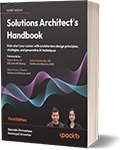Solutions Architect's Handbook - Third Edition
Software Development
Book Details
Book Title
Solutions Architect's Handbook - Third Edition: Kick-start your career with architecture design principles, strategies, and generative AI techniques Edition: 3
Author
Saurabh Shrivastava, Neelanjali Srivastav
Publisher
Packt Publishing
Publication Date
March 2024
ISBN
1835084230
Number of Pages
579
Language
English
Format
File Size
13.2MB
Subject
Software Architecture
Table of Contents
- Cover
- Copyright
- Forewords
- Contributors
- Table of Contents
- Preface
- Chapter 1: Solutions Architect in an Organization
- What is solution architecture?
- he solutions architect’s role
- Understanding a solutions architect’s responsibilities
- Solutions architect in an Agile organization
- Common challenges in the solutions architect role
- Career path and skill development for solutions architects
- Summary
- Chapter 2: Principles of Solution Architecture Design
- Building scalable architecture design
- Building a highly available and resilient architecture
- Making your architecture fault-tolerant
- Designing for performance
- Creating immutable architecture
- Think loose coupling
- Think service, not server
- Think data-driven design
- Adding security everywhere
- Making applications usable and accessible
- Building future-proof extendable and reusable architecture
- Ensuring architectural interoperability and portability
- Applying automation everywhere
- Plan for business continuity
- Design for operation
- Overcoming architectural constraints
- Summary
- Chapter 3: Cloud Migration and Cloud Architecture Design
- Public, private, and hybrid clouds
- Solution architecture in the public cloud
- Creating a cloud migration strategy
- Choosing a cloud migration strategy
- Steps for cloud migration
- Creating a hybrid cloud architecture
- Taking a multi-cloud approach
- Implementing CloudOps
- CloudOps pillars
- Summary
- Further reading
- Chapter 4: Solution Architecture Design Patterns
- Building an n-tier layered architecture
- Creating a multi-tenant SaaS-based architecture
- Understanding service-oriented architecture
- Building a cache-based architecture
- Model-View-Controller (MVC) architecture
- Building Domain-Driven Design (DDD)
- Understanding the circuit breaker pattern
- Implementing the bulkhead pattern
- Creating a floating IP pattern
- Deploying an application with a container
- Database handling in application architecture
- Clean Architecture
- Avoiding anti-patterns in solution architecture
- Summary
- Chapter 5: Cloud-Native Architecture Design Patterns
- What is cloud-native architecture?
- Building serverless architecture
- Building stateless and stateful architectural designs
- Creating a microservice architecture
- Reactive architecture
- Building queue-based architecture
- Pipes-and-Filters Architecture
- Creating Event-Driven Architecture
- Backend for Frontend pattern
- Cloud-native architecture anti-patterns
- Summary
- Chapter 6: Performance Considerations
- Design principles for high-performance architecture
- Technology selection for performance optimization
- Performance considerations for MOBIle applications
- Performance testing
- Managing performance monitoring
- Summary
- Chapter 7: Security Considerations
- Chapter 8:Architectural Reliability Considerations
- Design principles for architectural reliability
- Technology selection for architectural reliability
- Improving reliability with the cloud
- Summary
- Chapter 9:Operational Excellence Considerations
- Design principles for operational excellence
- Selecting technologies for operational excellence
- Achieving operational excellence in the public cloud
- Driving efficiency with CloudOps
- Summary
- Chapter 10:Cost Considerations
- Design principles for cost optimization
- Understanding techniques for cost optimization
- Driving cost optimization in the public cloud
- Green IT and its influence on cost considerations
- Summary
- Chapter 11:DevOps and Solution Architecture Framework
- Introducing DevOps
- Understanding the components of DevOps
- Introducing DevSecOps for Security
- Combining DevSecOps and CI/CD
- Implementing a CD strategy
- Best practices for choosing the right deployment strategy
- Implementing continuous testing in the CI/CD pipeline
- Using DevOps tools for CI/CD
- Implementing DevOps best practices
- Building DevOps and DevSecOps in the cloud
- Summary
- Chapter 12:Data Engineering for Solution Architecture
- What is big data architecture?
- Designing big data processing pipelines
- Data ingestion, storage, processing, and analytics
- Data storage in the cloud
- Visualizing data
- Designing big data architectures
- Big data architecture best practices
- Summary
- Chapter 13:Machine Learning Architecture
- What is machine learning?
- Working with data science and machine learning
- Machine learning in the cloud
- Building machine learning architecture
- Design principles for machine learning architecture
- MLOps
- Deep learning
- NLP
- Summary
- Chapter 14:Generative AI Architecture
- What is generative AI?
- Generative AI use cases
- The basic architecture of generative AI systems
- Popular generative AI FMs
- How to start with generative AI
- Generative AI reference architecture for building a mortgage assistant app
- Challenges in implementing generative AI
- Summary
- Chapter 15:Rearchitecting Legacy Systems
- Learning the challenges of legacy systems
- Defining a strategy for system modernization
- Looking at legacy system modernization techniques
- Defining a cloud migration strategy for legacy systems
- Mainframe migration with the public cloud
- Modernizing legacy code with generative AI
- Summary
- Chapter 16:Solution Architecture Document
- Purpose of the SAD
- Views of the SAD
- Structure of the SAD
- Life cycle of the SAD
- SAD best practices and common pitfalls
- IT procurement documentation for a solution architecture
- Summary
- Chapter 17:Learning Soft Skills to Become a Better Solutions Architect
- Importance of soft skills in solution architecture
- Acquiring pre-sales skills
- Taking ownership and accountability
- Being flexible and adaptable
- Design thinking
- Being a builder by engaging in coding hands-on
- Becoming better with continuous learning
- Being a mentor to others
- Becoming a technology evangelist and thought leader
- Summary
- PacktPage
- Index
